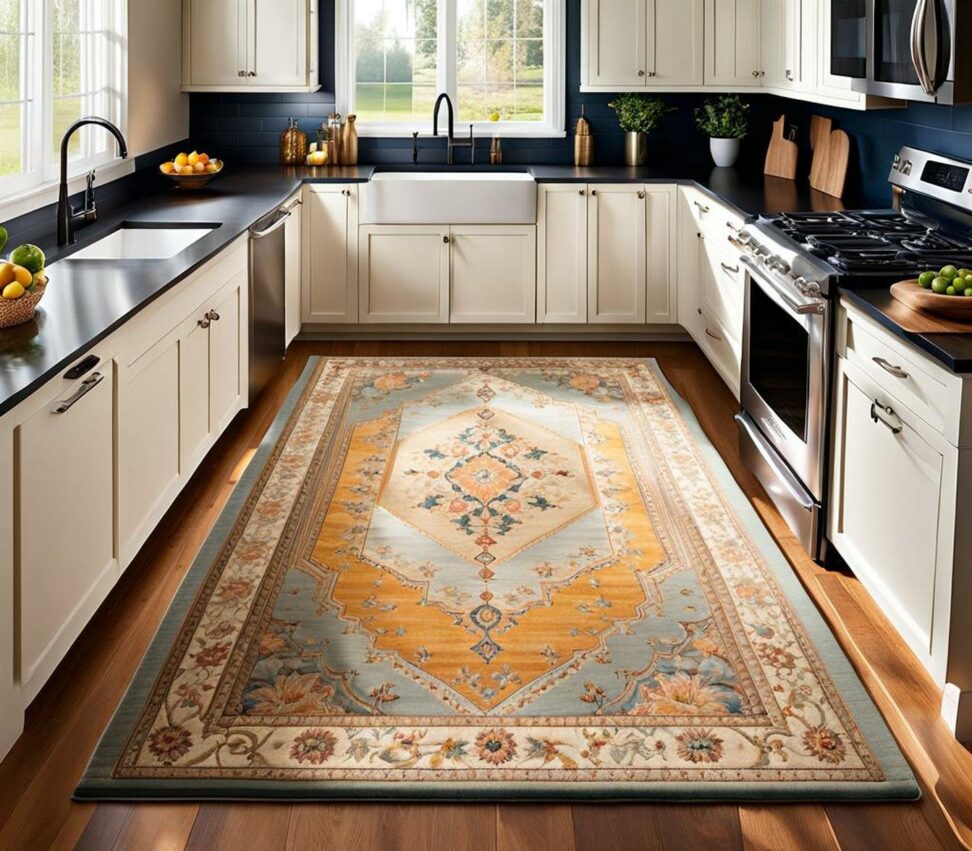Shape Up Your Kitchen's Look with a Stylish Rug
When it comes to kitchen decor, the rug you choose can make or break the overall aesthetic. The right rug not only protects your floors but transforms the space, pulling the look together.
With so many options for size, shape, color, and texture, it can be tricky to find the perfect fit. Follow these tips to select a rug that complements your kitchen's style.

Choose the Right Size Rug for Your Kitchen
One of the most important factors in picking a kitchen rug is getting the size right. You'll want one large enough to fit comfortably under your table and chairs.
Start by measuring your table size as well as the surrounding floor space. Allow an extra 24-36 inches of rug on all sides beyond the edges of the table. This gives you sufficient room to pull chairs out and sit down without sliding off.
Many standard sizes like 5'x8' or 8'x10' work for average kitchen spaces. For particularly small or large kitchens, custom-sized rugs can provide an exact fit.
Avoid Oversized Rugs in Small Kitchens
It may be tempting to use a large rug in a small kitchen to make the space appear bigger. However, an oversized area rug can have the opposite effect by making the room seem even smaller and cluttered.
Stick to a rug that's proportionate for petite kitchens. Leave at least 12 inches of open floor around the edges for visual breathing room.
Complement Your Table Shape with a Matching Rug
Beyond size, consider how a rug's shape can complement your kitchen's layout. Rectangular rugs work well for most standard table shapes and elongated kitchen floor plans.
For round, oval, or octagonal dining tables, choose a rug in a similar rounded shape. The continuity in shape brings harmony to the space.
In kitchens with multiple tables or unique layouts, positioning matching or contrasting rug shapes strategically can improve flow.
Use Oval and Octagonal Rugs to Complement Unique Table Shapes
It can be tricky finding rugs to fit unconventional table shapes like octagons. Custom-cut oval and octagonal rugs are ideal for matching the table outline exactly.
Or use a boldly patterned rectangular rug under an octagonal table to provide contrast. Align the table centered on top of the rug.
Choose a Durable and Easy-Clean Rug Material
Kitchens demand rugs that can stand up to high traffic, spills, pulled out chairs, and table legs. Wool is the gold standard for durability and stain resistance.
Cotton, jute, or synthetics like polypropylene are budget-friendly options. But be aware these materials are less resistant to spills and moisture.
For easy maintenance, synthetic or low pile wool rugs clean up quickly. Avoid silk or other delicate fabrics prone to staining.
Wool Blend Rugs Offer Durability at Lower Cost
Wool rugs are an ideal choice but come at a higher price point. Seek out wool-synthetic blends to get some of wool's benefits at a lower cost.
Alternatively, choose wool for higher traffic areas only, pairing it with cottons or synthetics in lower spill-risk spots.
Rug Textures That Add Visual Interest and Comfort
From plush shags to tightly woven jute, rug texture impacts both aesthetics and function. Lower pile feels firm underfoot, while thicker piles are luxuriously soft.
In modern kitchens, thin pile or flat-woven rugs offer an understated look. For farmhouse or traditional spaces, bump up the coziness with shag and cable textures.
Adding a rug pad underneath increases cushioning and prevents slips on smooth flooring like tile or wood.
Quick-Cleaning Low Pile for Contemporary Kitchens
For easy maintenance, contemporary kitchens benefit from smoother piles like low loop or Berber textures. Their tight weaves resist spills and vacuum up effortlessly.
Pair with a thin, grippy rug pad that won't impede chair movement. Check rug corners routinely for loose threads or fraying.
Vibrant Colors and Patterns to Brighten Your Kitchen
Like artwork for the floor, an area rug brings color into kitchens. You can pick up existing tones from walls, backsplash or accessories. Or make the rug the launching point for a bold new palette.
Patterns and prints layered over solid backgrounds add striking visual texture. Florals, geometric shapes, or subtle stripes enliven floors cost-effectively.
Coordinate your rug design with kitchen textiles like curtains, placemats, and dishtowels for a pulled-together look.
Warm Neutral Tones for Inviting Kitchen Rugs
For a welcoming vibe, earthy neutrals like beige, tan, or light brown make versatile rug colors. They elegantly blend with any style from modern farmhouse to traditional.
Charcoal grey and soft blues are sophisticated options. Accent with pale yellows or sage greens for brightness against dark wood cabinets.
Clever Rug Placement for Functional Kitchens
Typically kitchen rugs go under the dining table, with chairs resting on top. This defines the main functional area of the room.
Alternatively, center your rug under key work zones like islands, sinks or stoves. Leave the table area bare to facilitate easy cleaning.
In open concept kitchens, place separate rugs under distinct spaces. Floating rugs help divide the room without impeding flow.
Consider how you move through your kitchen during food prep and cleanup. Position rugs to support this natural work flow.
Align the edges of an island rug parallel to cabinets for a streamlined look. Run a stoveline rug perpendicular to the counter to contain messes.
Keep edges from curling with rug tape or pads. Rotate periodically to equalize wear in high-activity kitchens.
With a stylish, well-sized rug anchoring your kitchen, you're ready to enjoy this high-functioning heart of the home in comfort and flair.